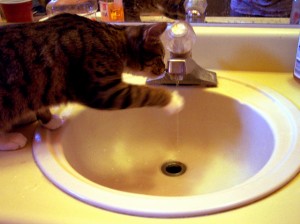Q: “I have a female adult cat named Sarah, I’m not sure how old she is as she’s a rescue, but she’s roughly 5 or maybe 6 years old. I’ve had her for 4 years now and she’s perfectly happy otherwise but she refuses to drink from her water bowl. It’s like she doesn’t know what it’s there for. She eats from the food bowls but then she’ll sit in the bath or shower and beg for me to turn on the water. I’ve also seen her drink water from puddles outside. Our other cat Sally (they were adopted together) doesn’t have any problems using the water bowl. I’m worried Sarah gets thirsty on hot days when there’s no water outside and I’m not home to run her water in the tub.” – Jessica C.
A: Most cats prefer to drink in separate locations from where they eat. Large ceramic water bowls are preferred over plastic or metal. Large ceramic salad or soup bowls, serving bowls, or medium sized ceramic dog food bowls work well for water bowls. Make sure the bowl has a wide mouth. Most pet food and water bowls are too small for cats and get in the way of a cat’s whiskers. Water bowls are best placed near sleeping areas or in social areas (from the cat’s perspective), such as in living rooms, bedrooms, near cat condos or window perches. Cats also like to position themselves so they have a nice vantage point or landscape view of an area. Place a water bowl so that Sarah can see all entries and exits of a room when she is drinking from it, and make sure the water bowl is a few inches away from a wall. See Tips to Have a Happy Cat. Some cats also like running water. There are some cat fountains on the market, but avoid plastic fountains, and some are difficult to clean. You’ll most likely find that the bowl recommendations mentioned will encourage Sarah to drink quite a bit more.

Q: “I have a 13 yrs old male neutered cat, called Jimmy. He never had any real health problems until last year. Because of some wrong diagnoses and several trips to the vet for “constipation”, an abscess close to his anus and long months of having trouble with doing his business, he finally resorted to going to poop in the garden only. I believe he figured that he experienced pain when doing it in the litter box and by accident found out, outside it worked without any pain. Actually I don’t have a problem with him, going outside, but I only let him outside when I am at home. While I am at work he stays inside. Whenever I don’t get home in time he poops inside everywhere. He seems to get in a panic, doesn’t know where to go. He already chose weird places like stools and kitchen counters and he also spread it all over the place, running while doing his business and leaving his droplets everywhere.
I am afraid not to go home right after work and not letting him out in time. Also we are going to move in July, I am worried he won’t accept his new garden to go outside and become very stressed by the new surroundings. I tried different litter boxes (we already have any imaginable kind of litter box…), different litter, different locations. I never ever punished him for doing his business not in the litter box, I only get rid of the mess quietly. He does use his litter box for peeing, but only in winter, when it’s cold outside. Please, what else can I try to convince him to use his litter box again?” – Monika Z.
A: Most cats like to urinate and defecate in separate locations. When an additional cat is present, this makes it even more important. Stool is dirtier than urine, so oftentimes a cat will urinate more than once in box, but if there is poop in it, they will prefer to go somewhere else. The smaller the box, the more pronounced this is, as the dirtier the box gets. Large open sweater boxes work well, 6″ in height and large enough in length so that Jimmy can stand in it with still a few inches to either side of him remaining. Many cats have to step outside of the box, or bump into the sides of the box or wall, to turn around. Boxes should not be flush to a wall. Placement of boxes is important too. Boxes should be placed in areas where Jimmy can have a vantage point or landscape view of an area. The box should not be placed in locations behind corners or doors. Cats also prefer find sandy like litters. Unscented is a must. Clumping clay works best. Clumping removes urine, so the box can be kept cleaner. The box should be scooped ideally as often as possible, but minimally 2-3 times a day, once in the morning, after work and before bed.
If you put two boxes in the same location, make sure they are separated from each other, ideally perpendicular to each other on separate walls (Be sure to keep boxes a few inches away from a wall as well). If Jimmy has experienced pain when defecating, there no doubt can be a negative association with the box. Behavioral adjustments and making the litter pan arrangement as appealing as possible are important. If Jimmy is still experiencing discomfort, redness, or soreness, or constipation or diarrhea, getting him medically checked again and working on dietary changes may also help. Please see the article on How to Resolve a Litter Box Problem.
